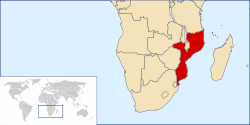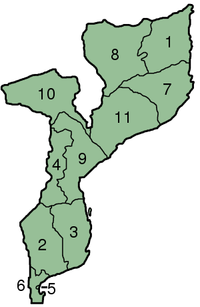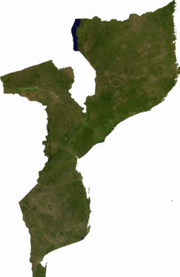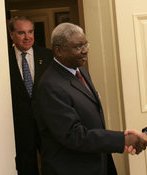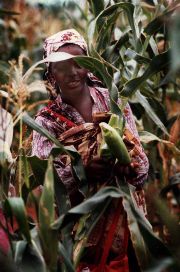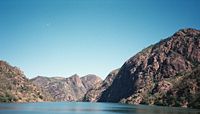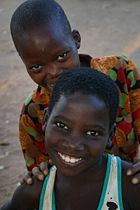Mozambique
2008/9 Schools Wikipedia Selection. Related subjects: Africa; African Countries
| República de Moçambique Republic of Mozambique
|
||||||
|---|---|---|---|---|---|---|
|
||||||
| Motto: none | ||||||
| Anthem: Pátria Amada (formerly Viva, Viva a FRELIMO) |
||||||
|
|
||||||
| Capital (and largest city) |
Maputo |
|||||
| Official languages | Portuguese | |||||
| Demonym | Mozambican | |||||
| Government | Republic | |||||
| - | President | Armando Guebuza | ||||
| - | Prime Minister | Luísa Diogo | ||||
| Independence | ||||||
| - | from Portugal | June 25, 1975 | ||||
| Area | ||||||
| - | Total | 801,590 km² ( 35th) 309,496 sq mi |
||||
| - | Water (%) | 2.2 | ||||
| Population | ||||||
| - | 2007 census | 21,397,000 (52nd) | ||||
| - | Density | 25/km² ( 178th) 65/sq mi |
||||
| GDP ( PPP) | 2005 estimate | |||||
| - | Total | $27.013 billion ( 100th) | ||||
| - | Per capita | $1,389 ( 158th) | ||||
| Gini (1996-97) | 39.6 (medium) | |||||
| HDI (2007) | ▼ 0.384 (low) ( 172nd) | |||||
| Currency | Mozambican metical (Mtn) ( MZN) |
|||||
| Time zone | CAT ( UTC+2) | |||||
| - | Summer ( DST) | not observed ( UTC+2) | ||||
| Internet TLD | .mz | |||||
| Calling code | +258 | |||||
| 1 | Estimates for this country explicitly take into account the effects of excess mortality due to AIDS; this can result in lower life expectancy, higher infant mortality and death rates, lower population and growth rates, and changes in the distribution of population by age and sex than would otherwise be expected. | |||||
Mozambique, officially the Republic of Mozambique (Portuguese: Moçambique or República de Moçambique, pronounced [ʁɛ'publikɐ dɨ musɐ̃'bikɨ]), is a country in southeastern Africa bordered by the Indian Ocean to the east, Tanzania to the north, Malawi and Zambia to the northwest, Zimbabwe to the west and Swaziland and South Africa to the southwest. It was explored by Vasco da Gama in 1498 and colonized by Portugal in 1505. By 1510, the Portuguese had control of all of the former Arab sultanates on the east African coast. From about 1500, Portuguese trading posts and forts became regular ports of call on the new route to the east.
It is a member of the Community of Portuguese Language Countries and the Commonwealth of Nations. Mozambique (Moçambique) was named after Muça Alebique, a sultan.
History
Between the first and fourth centuries AD, waves of Bantu-speaking people migrated from the west and north through the Zambezi River valley and then gradually into the plateau and coastal areas. The Bantu were farmers and ironworkers.
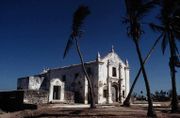
When Portuguese explorers reached Mozambique in 1498, Arab commercial and slave trading settlements had existed along the coast and outlying islands for several centuries. From about 1500, Portuguese trading posts and forts became regular ports of call on the new route to the east. Later, traders and prospectors penetrated the interior regions seeking gold and slaves. Although Portuguese influence gradually expanded, its power was limited and exercised through individual settlers and officials who were granted extensive autonomy. As a result, investment lagged while Lisbon devoted itself to the more lucrative trade with India and the Far East and to the colonisation of Brazil.
By the early 20th century the Portuguese had shifted the administration of much of Mozambique to large private companies, like the Mozambique Company, the Zambezi Company and the Niassa Company, controlled and financed mostly by the British, which established railroad lines to neighbouring countries and supplied cheap – often forced – African labor to the mines and plantations of the nearby British colonies and South Africa. Because policies and development plans were primarily designed by the ruling authorities for the benefit of Mozambique's Portuguese population, little attention was paid to Mozambique's tribal integration and the development of its native communities. This affected a majority of the indigenous population who suffered both state-sponsored discrimination and enormous social pressure. Many felt they had received too little opportunity or resources to upgrade their skills and improve their economic and social situation to a degree comparable to that of the Europeans.
The Front for the Liberation of Mozambique (FRELIMO), initiated a guerrilla campaign against Portuguese rule in September 1964. This conflict, along with the two others already initiated in the other Portuguese colonies of Angola and Guinea-Bissau, became part of the so-called Portuguese Colonial War (1961-1974).
After 10 years of sporadic warfare and Portugal's return to democracy through a leftist military coup in Lisbon (the Carnation Revolution of April 1974), FRELIMO took control of the territory. Within a year, almost all Portuguese population had left – some expelled by the government of the newly-independent territory, some fleeing in fear –, and Mozambique became independent from Portugal on June 25, 1975.
Conflict and civil war
The new government, under president Samora Machel, gave shelter and support to South African ( African National Congress) and Zimbabwean ( Zimbabwe African National Union) liberation movements while the governments of first Rhodesia and later South Africa (at that time still operating the Apartheid laws) fostered and financed an armed rebel movement in central Mozambique called the Mozambican National Resistance (RENAMO). Hence, civil war, sabotage from neighbouring white-ruled states such as Rhodesia and the Apartheid regime of South Africa, and economic collapse characterized the first decade of Mozambican independence. Also marking this period were the mass exodus of Portuguese nationals and Mozambicans of Portuguese heritage, a weak infrastructure, and government nationalisation of privately owned industries. During most of the civil war, the government was unable to exercise effective control outside of urban areas, many of which were cut off from the capital. An estimated one million Mozambicans perished during the civil war, 1.7 million took refuge in neighbouring states, and several million more were internally displaced. On October 19, 1986 Samora Machel was on his way back from an international meeting in Zambia in the presidential Tupolev Tu-134 aircraft when the plane crashed in the Lebombo Mountains, near Mbuzini. There were nine survivors but President Machel and twenty-four others died, including ministers and officials of the Mozambique government. The United Nations' Soviet Union delegation issued a minority report contending that their expertise and experience had been undermined by the South Africans. Representatives of the Soviet Union advanced the theory that the plane had been intentionally diverted by a false navigational beacon signal, using a technology provided by military intelligence operatives of the South African government (at that time still operating the laws of Apartheid). Machel's successor, Joaquim Chissano, continued the reforms and began peace talks with RENAMO. The new constitution enacted in 1990 provided for a multi-party political system, market-based economy, and free elections. The civil war ended in October 1992 with the Rome General Peace Accords, brokered by the Community of Sant'Egidio. Under supervision of the ONUMOZ peacekeeping force of the United Nations, peace returned to Mozambique.
By mid-1995 the more than 1.7 million Mozambican refugees who had sought asylum in neighbouring Malawi, Zimbabwe, Swaziland, Zambia, Tanzania, and South Africa as a result of war and drought had returned, as part of the largest repatriation witnessed in sub-Saharan Africa. Additionally, a further estimated four million internally displaced persons returned to their areas of origin.
Foreign relations
While allegiances dating back to the liberation struggle remain relevant, Mozambique's foreign policy has become increasingly pragmatic. The twin pillars of Mozambique's foreign policy are maintenance of good relations with its neighbours and maintenance and expansion of ties to development partners.
During the 1970s and the early 1980s, Mozambique's foreign policy was inextricably linked to the struggles for majority rule in Rhodesia and South Africa as well as superpower competition and the Cold War. Mozambique's decision to enforce UN sanctions against Rhodesia and deny that country access to the sea led Ian Smith's government to undertake overt and covert actions to destabilize the country. Although the change of government in Zimbabwe in 1980 removed this threat, the government of South Africa (at that time still operating under the laws of Apartheid) continued to finance the destabilization of Mozambique. It also belonged to the Front Line States.
The 1984 Nkomati Accord, while failing in its goal of ending South African support to RENAMO, opened initial diplomatic contacts between the Mozambican and South African governments. This process gained momentum with South Africa's elimination of apartheid, which culminated in the establishment of full diplomatic relations in October 1993. While relations with neighbouring Zimbabwe, Malawi, Zambia, and Tanzania show occasional strains, Mozambique's ties to these countries remain strong.
In the years immediately following its independence, Mozambique benefited from considerable assistance from some Western countries, notably the Scandinavians. The Soviet Union and its allies, however, became Mozambique's primary economic, military, and political supporters and its foreign policy reflected this linkage. This began to change in 1983; in 1984 Mozambique joined the World Bank and International Monetary Fund. Western aid quickly replaced Soviet support, with the Scandinavians countries of Sweden, Norway, Denmark and Iceland. Finland and the Netherlands are becoming increasingly important sources of development assistance. Italy also maintains a profile in Mozambique as a result of its key role during the peace process. Relations with Portugal, the former colonial power, continue to play an important role as Portuguese investors play a visible role in Mozambique's economy.
Mozambique is a member of the Non-Aligned Movement and ranks among the moderate members of the African bloc in the United Nations and other international organisations. Mozambique also belongs to the African Union (formerly the Organisation of African Unity) and the Southern African Development Community. In 1994, the government became a full member of the Organisation of the Islamic Conference, in part to broaden its base of international support but also to please the country's sizable Muslim population. Similarly, in early 1996 Mozambique joined its Anglophone neighbours in the Commonwealth of Nations. It is the only nation to join the Commonwealth that was never part of the British Empire. In the same year, Mozambique became a founding member and the first President of the Community of Portuguese Language Countries (CPLP), and maintains close ties with other Lusophone states.
Provinces, districts, and postos
Mozambique is divided into ten provinces (provincias) and one capital city (cidade capital) with provincial status. The provinces are subdivided into 129 districts (distritos). The districts are further divided in 405 "Postos Administrativos" (Administrative Posts) and then into Localidades (Localities), the lowest geographical level of the central state administration. Since 1998, 33 "Municípios" (Municipalities) have been created in Mozambique.
|
Geography and climate
At 309,475 square miles (801,590 km²), Mozambique is the world's 35th-largest country (after Pakistan). It is comparable in size to Turkey.
Mozambique is located on the southeast coast of Africa. It is bound by Swaziland to the south, South Africa to the southwest, Zimbabwe to the west, Zambia and Malawi to the northwest, Tanzania to the north and the Indian Ocean to the east. The country is divided into two topographical regions by the Zambezi River. To the North of the Zambezi River, the narrow coastline moves inland to hills and low plateaux, and further west to rugged highlands, which include the Niassa highlands, Namuli or Shire highlands, Angonia highlands, Tete highlands and the Makonde plateau. To the South of the Zambezi River, the lowlands are broader with the Mashonaland plateau and Lebomo mountains located in the deep south.

The country is drained by five principal rivers and several smaller ones with the largest and most important the Zambezi. The country has three lakes, Lake Niassa or Malawi, Lake Chiuta and Lake Shirwa, all in the north. The major cities are Maputo, Beira, Nampula, Tete, Quelimane, Chimoio, Pemba, Inhambane, Xai-Xai and Lichinga.
Mozambique has a tropical climate with two seasons. A wet season from October to March and a dry season from April to September. Climatic conditions, however, vary depending on altitude. Rainfall is heavy along the coast and decreases in the north and south. Annual precipitation varies from 500 to 900 mm (20 to 35 inches) depending on the region with an average of 590 mm (23 inches). Cyclones are also common during the wet season. Average temperature ranges in Maputo are from 13 to 24 degrees Celsius (55 to 75 degrees Fahrenheit) in July to 22 to 31 degrees Celsius (72 to 88 degrees Fahrenheit) in February.
Politics
Mozambique is a multi-party democracy under the 1990 constitution. The executive branch comprises a president, prime minister, and Council of Ministers. There is a National Assembly and municipal assemblies. The judiciary comprises a Supreme Court and provincial, district, and municipal courts. Suffrage is universal at eighteen.
In the 1994 elections. Joaquim Chissano was elected President with 53% of the vote, and a 250-member National Assembly was voted in with 129 Liberation Front of Mozambique ( FRELIMO) deputies, 112 Mozambican National Resistance (RENAMO) deputies, and nine representatives of three smaller parties that formed the Democratic Union (UD). Since its formation in 1994, the National Assembly has made progress in becoming a body increasingly more independent of the executive. By 1999, more than one-half (53%) of the legislation passed originated in the Assembly.
After some delays, in 1998 the country held its first local elections to provide for local representation and some budgetary authority at the municipal level. The principal opposition party, RENAMO, boycotted the local elections, citing flaws in the registration process. Independent slates contested the elections and won seats in municipal assemblies. Turnout was very low.
In the aftermath of the 1998 local elections, the government resolved to make more accommodations to the opposition's procedural concerns for the second round of multiparty national elections in 1999. Working through the National Assembly, the electoral law was rewritten and passed by consensus in December 1998. Financed largely by international donors, a very successful voter registration was conducted from July to September 1999, providing voter registration cards to 85% of the potential electorate (more than seven million voters).
The second general elections were held December 3-5, 1999, with high voter turnout. International and domestic observers agreed that the voting process was well organised and went smoothly. Both the opposition and observers subsequently cited flaws in the tabulation process that, had they not occurred, might have changed the outcome. In the end, however, international and domestic observers concluded that the close result of the vote reflected the will of the people.
President Chissano won the presidency with a margin of 4% points over the RENAMO-Electoral Union coalition candidate, Afonso Dhlakama, and began his five-year term in January, 2000. FRELIMO increased its majority in the National Assembly with 133 out of 250 seats. RENAMO-UE coalition won 116 seats, one went independent, and no third parties are represented.
The opposition coalition did not accept the National Election Commission's results of the presidential vote and filed a formal complaint to the Supreme Court. One month after the voting, the court dismissed the opposition's challenge and validated the election results. The opposition did not file a complaint about the results of the legislative vote.
The second local elections, involving thirty-three municipalities with some 2.4 million registered voters, took place in November 2003. This was the first time that FRELIMO, RENAMO-UE, and independent parties competed without significant boycotts. The 24% turnout was well above the 15% turnout in the first municipal elections. FRELIMO won twenty-eight mayoral positions and the majority in twenty-nine municipal assemblies, while RENAMO won five mayoral positions and the majority in four municipal assemblies. The voting was conducted in an orderly fashion without violent incidents. However, the period immediately after the elections was marked by objections about voter and candidate registration and vote tabulation, as well as calls for greater transparency.
In May 2004, the government approved a new general elections law that contained innovations based on the experience of the 2003 municipal elections.
Presidential and National Assembly elections took place on December 1-2, 2004. FRELIMO candidate Armando Guebuza won with 64% of the popular vote. His opponent, Afonso Dhlakama of RENAMO, received 32% of the popular vote. FRELIMO won 160 seats in Parliament. A coalition of RENAMO and several small parties won the 90 remaining seats. Armando Guebuza was inaugurated as the President of Mozambique on February 2, 2005. RENAMO and some other opposition parties made claims of election fraud and denounced the result. These claims were supported by international observers (among others by the European Union Election Observation Mission to Mozambique and the Carter Centre) to the elections who criticised the fact that the National Electoral Commission (CNE) did not conduct fair and transparent elections. They listed a whole range of shortcomings by the electoral authorities that benefited the ruling party FRELIMO. However, according to EU observers, the elections shortcomings have probably not affected the final result in the presidential election. On the other hand, the observers have declared that the outcome of the parliamentary election and thus the distribution of seats in the National Assembly does not reflect the will of the Mozambican people and is clearly to the disadvantage of RENAMO.
The Reporters Without Borders' Worldwide Press Freedom Index 2006 ranked Mozambique 45th out of 168 countries.
Economy
The official currency is the New Metical (as of 2007, 1 USD is roughly equivalent to 25 Meticals), which replaced old Meticals in rate thousand to one. The old currency will be redeemed by the Bank of Mozambique until the end of 2012. The US dollar, South African rand, and recently the Euro are also widely accepted and used in business transactions. The minimum legal salary is around US$60 per month. Mozambique is member of the Southern African Development Community (SADC). The SADC free trade protocol is aimed at making the Southern African region more competitive by eliminating tariffs and other trade barriers.
Rebounding growth
The resettlement of civil war refugees and successful economic reform have led to a high growth rate: the average growth rate from 1993 to 1999 was 6.7%; from 1997 to 1999 it averaged more than 10% per year. The devastating floods of early 2000 slowed GDP growth to 2.1%. A full recovery was achieved with growth of 14.8% in 2001. In 2003, the growth rate was 7%. The government projects the economy to continue to expand between 7%-10% a year for the next five years, although rapid expansion in the future hinges on several major foreign investment projects, continued economic reform, and the revival of the agriculture, transportation, and tourism sectors. More than 75% of the population engages in small scale agriculture, which still suffers from inadequate infrastructure, commercial networks, and investment. However, 88% of Mozambique's arable land is still uncultivated. In addition, the profitable exploitation of valuable titanium reserves has the potential to uplift this poverty stricken region of Africa. As a natural resource, it could play a significant role in solving unemployment and poverty.
Inflation
The government's tight control of spending and the money supply, combined with financial sector reform, successfully reduced inflation from 70% in 1994 to less than 5% in 1998-99. Economic disruptions stemming from the devastating floods of 2000 caused inflation to jump to 12.7% that year, and it was 13% in 2003. The Mozambique's currency, the Metical (MZN), devaluated by 50% to the dollar in 2001, although in late 2001 it began to stabilize. Since then, it has held steady at about 24,000 MZN to 1 U.S. dollar. New Metical replaced old Meticals in rate thousand to one on January 1, 2007 bringing the exchange rate to 25 (new) MZN to 1 USD.
Economic reforms
More than 1,200 state-owned enterprises (mostly small) have been privatised. Preparations for privatisation and/or sector liberalisation are underway for the remaining parastatal enterprises, including telecommunications, energy, ports, and the railways. The government frequently selects a strategic foreign investor when privatising a parastatal. Additionally, customs duties have been reduced, and customs management has been streamlined and reformed. The government introduced a value-added tax in 1999 as part of its efforts to increase domestic revenues. Plans for 2003-04 include Commercial Code reform; comprehensive judicial reform; financial sector strengthening; continued civil service reform; and improved government budget, audit, and inspection capability. Further political instability resulting from the floods left thousands homeless, displaced within their own country.
Improving trade imbalance
Imports remain almost 40% greater than exports, but this is a significant improvement over the 4:1 ratio of the immediate post-war years. In 2003, imports were $1.24 billion and exports were $910 million. Support programs provided by foreign donors and private financing of foreign direct investment mega-projects and their associated raw materials, have largely compensated for balance-of-payments shortfalls. The medium-term outlook for exports is encouraging, since a number of foreign investment projects should lead to substantial export growth and a better trade balance. MOZAL, a large aluminium smelter that commenced production in mid-2000, has greatly expanded the nation's trade volume. Traditional Mozambican exports include cashews, shrimp, fish, copra, sugar, cotton, tea, and citrus fruits. Most of these industries are being rehabilitated. As well, Mozambique is less dependent on imports for basic food and manufactured goods because of steady increases in local production.
Demographics
The north-central provinces of Zambezia and Nampula are the most populous, with about 45% of the population. The estimated four million Macua are the dominant group in the northern part of the country; the Sena and Shona (mostly Ndau) are prominent in the Zambezi valley, and the Shangaan (Tsonga) dominate in southern Mozambique. Other groups include Makonde, Yao, Swahili, Tonga, Chopi, and Nguni (including Zulu). Bantu people comprise 99.66% of the population, the remaining 0.34% include Europeans 0.06% (largely of Portuguese ancestry), Euro-Africans 0.2% (mestiço people of mixed Bantu and Portuguese heritage), and Indians 0.08%. During Portuguese colonial rule, a large minority of people of Portuguese descent lived permanently in almost all areas of the country, and Mozambicans with Portuguese blood at the time of independence numbered about 260,000. Most of these left the region after independence from Portugal in 1975. The remaining minorities in Mozambique claim heritage from Pakistan, Portuguese India and Arab countries. There are also some 7,000 Chinese.
Despite the influence of Islamic coastal traders and European colonisers, the people of Mozambique have largely retained an indigenous culture based on small-scale agriculture. Mozambique's most well-known art forms are wood sculpture, for which the Makonde in northern Mozambique are particularly renowned, and dance. The middle and upper classes continue to be heavily influenced by the Portuguese colonial and linguistic heritage.
Languages
Portuguese is the official and most widely spoken language of the nation, because Bantus speak several of their different languages (most widely used of these are Swahili, Makhuwa, Sena, Ndau, and Shangaan — these have many Portuguese-origin words), but 40% of all people speak it — 33.5%, mostly Bantus, as their second language and only 6.5%, mostly white Portuguese and mestiços, speak it as their first language. Arabs, Chinese, and Indians speak their own languages (Indians from Portuguese India speak any of the Portuguese Creoles of their origin) aside from Portuguese as their second language. Most educated Mozambicans speak English, which is used in schools and business as second or third language.
Education
Under Portuguese rule, educational opportunities for poor Mozambicans were limited; Most of the Bantu population was illiterate, and many could not speak Portuguese. In fact, most of today's political leaders were educated in missionary schools. After independence, the government placed a high priority on expanding education, which reduced the illiteracy rate to about two-thirds as primary school enrollment increased. Unfortunately in recent years, school construction and teacher training enrollments have not kept up with population increases. With post-war enrollments reaching all-time highs, the quality of education has suffered. All Mozambicans are required by law to attend school through the primary level. After grade 7, students must take standardised national exams to enter secondary school, which runs from 8th to 10th grade. Secondary school students study Portuguese, mathematics, biology, chemistry, physics, history, geography, physical education, technical drawing, and English (which all schoolchildren begin in grade 6). Another round of national exams after grade 10 allows passage into pre-university school (grades 11 and 12), in which students have the opportunity to study all of the former subjects (minus physical education) plus philosophy and French. Space in Mozambican universities is extremely limited; thus most students who complete pre-university school do not immediately proceed onto university studies. Many go to work as teachers or are unemployed. There are also institutes specialising in agricultural, technical, or pedagogical studies which students may attend after grade 10 in lieu of a pre-university school, which give more vocational training. A lot of children in Mozambique don't go to primary school because they have to work for their families' subsistence farms for a living.
Religion
According to the 1997 Second General Population and Housing Census, the religions of the polled population were as follows: 34.2% identified themselves as Roman Catholic; 24.25% claimed to not be affiliated with a religion; 18.7% adhering to Zionism (an African form of Christianity); 7.8% of the population were cited as Muslims; 11.45% as other non-Catholic Christians; 3.6% as "other".
The Roman Catholic Church has established twelve dioceses (Beira, Chimoio, Gurué, Inhambane, Lichinga, Maputo, Nacala, Nampula, Pemba, Quelimane, Tete, and Xai-Xai - archdioceses are Beira, Maputo and Nampula). Statistics for the dioceses range from a low 7.44% Catholics in the population in the diocese of Chimoio, to 87.50% in Quelimane diocese (2006 official Catholic figures).
Muslims are particularly present in the north of the country. They are organised in several "tariqa" or brotherhoods (of the Qadiriya or Shadhuliyyah branch). Two national organisations also exist - the Conselho Islamico de Moçambique (reformists) and the Congresso Islamico de Mocambique (pro-sufi). There are also important Indo-Pakistani associations as well as some Shia and particularly Ismaili communities.
Among the main Protestant churches are Igreja União Baptista de Moçambique, the Assembleias de Deus, the Seventh-day Adventists, the Anglican Church of Southern Africa, the Igreja do Evangelho Completo de Deus, the Igreja Metodista Unida, the Igreja Presbiteriana de Moçambique, the Igreja de Cristo and the Assembleia Evangélica de Deus. The Church of Jesus Christ of Latter-day Saints is also present as well as the Jehovah's Witnesses, the Brazilian Igreja Universal do Reino de Deus, and the Salvation Army.
Music
Mozambique has distinct styles of music and distinct patterns of use of instruments. Some of the music styles fall into the classification of Lusophone musical culture.


